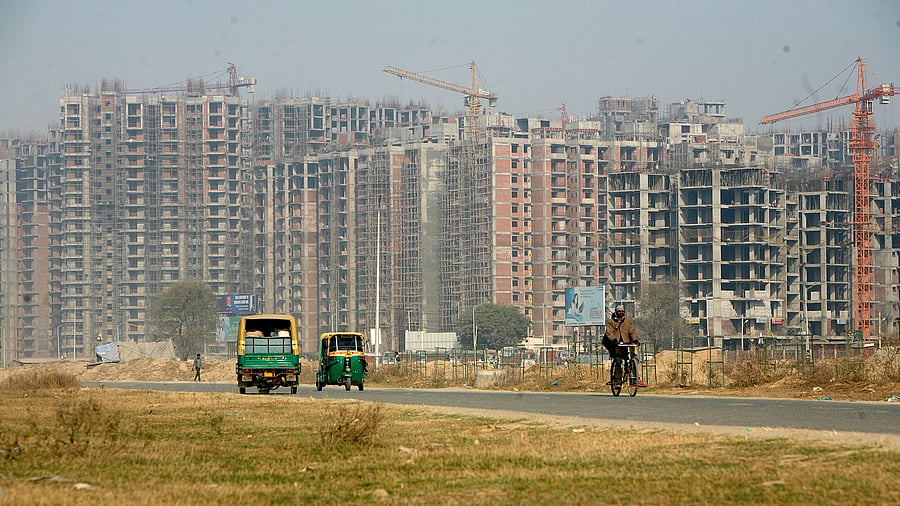
Residential buildings under construction. Image for representation.
Credit: iStock Photo
Punjab, once India’s agricultural granary, is now on the verge of a radical transformation — one that could have devastating long-term consequences. The Aam Aadmi Party (AAP)-led state government’s proposed land use change in cities such as Ludhiana, Jalandhar, Amritsar, and Patiala has sparked concern among urban planners, environmentalists, and social activists. The point of concern is the shift in policy, moving from an agriculture-based economy to one driven by real estate speculation.
Preliminary estimates suggest that Ludhiana alone is expected to witness the conversion of ~24,311 acres of agricultural land into residential colonies. This, however, is not an isolated development; it forms part of a broader ‘urban growth model’. The question is: development at what cost?
A misguided vision of growth?
The Punjab government’s push to promote real estate as a major economic driver is being marketed as a modernisation effort. Officials argue that with an increasing urban population, there is a need for more housing, infrastructure, and commercial spaces. Yet, critics say that this rationale is flawed and dangerously short-sighted.
The State Disaster Management Plan itself raises red flags. It underscores the critical vulnerabilities posed by unregulated urban expansion — flooding, groundwater depletion, waste management failures, and increased exposure to climate-induced disasters. Punjab, already facing severe ecological strain due to depleting water tables and deteriorating air quality, risks worsening its situation by encouraging urban sprawl over fertile agricultural land.
Urban development in Punjab has not kept pace with the basic principles of sustainability. Existing cities are already reeling under pressure. Solid waste is dumped in overflowing landfills, untreated sewage finds its way into rivers, and drainage systems collapse at the first sign of heavy rain. Do we really need to urbanise at this reckless pace?
Lessons ignored from Bengaluru
The warning signs are visible, and so are the lessons — from Bengaluru, for example. Once hailed as India’s Silicon Valley, the city today stands as a cautionary tale. Its lakes are toxic, traffic is unmanageable, and unplanned growth has led to severe flooding during monsoons. Bengaluru’s crisis stems largely from haphazard change in land use and unchecked construction — exactly what Punjab seems to be repeating.
Despite the availability of data, policymakers in Punjab appear to be ignoring these cautionary signals.
Housing for whom?
In many parts of urban India, housing development has often catered not to the real needs of the population, but to speculative interests. Luxury villas and gated colonies spring up, while the working classes and urban poor remain underserved. In Punjab, the situation could be more tragic. The new urban projects are expected to displace thousands, not just landowners but also sharecroppers and farm labourers, who depend on agricultural land for survival. Protests have already started on the streets.
Unfortunately, the state lacks a comprehensive rehabilitation policy for these displaced communities. There are no guarantees of alternate livelihoods or land. In fact, the current land policy framework is murky at best. It is largely developer-centric, designed to facilitate acquisition rather than protect local communities or ecological balance.
Employment mirage
One of the main arguments for aggressive urbanisation is job creation. Yet, this claim does not stand scrutiny. Most real estate-driven urban projects are capital-intensive and provide only short-term, low-paying construction jobs. They do little to ensure sustainable employment. On the other hand, agriculture — despite being undervalued in policy — supports a large part of Punjab’s workforce, both formally and informally.
Moreover, by shifting focus away from agriculture, the State risks increasing urban unemployment and further migration pressures, without the infrastructure to support them.
Policy vacuum and accountability
The ongoing land transformation in Punjab reflects a policy vacuum—an absence of long-term vision and data-backed planning. There is little transparency in how decisions are made. Are environmental impact assessments being conducted? What are the criteria for determining land use change? Is there any cap on how much land can be converted in a district?
The State Disaster Management document, while acknowledging risks, seems to have no enforcement authority in shaping land policy. This reflects a dangerous disconnect between risk assessment and policy execution.
Towards a more equitable and sustainable urban future
If Punjab is to urbanise, it must do so intelligently. It needs to conduct scientific assessments of housing needs; the land policies must be inclusive where the sharecroppers and landless farmers are protected; zoning regulations that prioritise environmental sustainability must be implemented; the government must invest in waste management and infrastructure upgrades in existing cities before expanding, and; decentralised development, where cities are not overburdened, must be encouraged.
Urban growth should be a tool for social transformation and economic opportunity, not a mechanism for ecological destruction and social displacement. Punjab stands at a crossroads. One path leads to a short-lived real estate boom with long-term fallout. The other, a more deliberate and equitable model of urbanisation that respects its agrarian legacy while planning for the future.
Which path it chooses will define the soul of Punjab for decades to come.
(Tikender Singh Panwar is former deputy mayor, Shimla, and member, Kerala Urban Commission.)
Disclaimer: The views expressed above are the author's own. They do not necessarily reflect the views of DH.